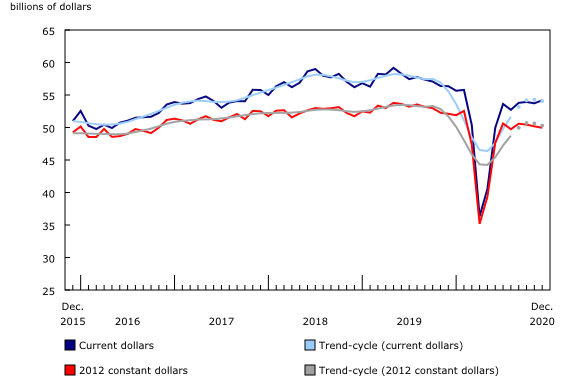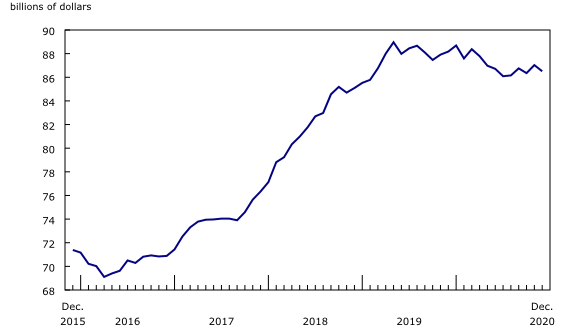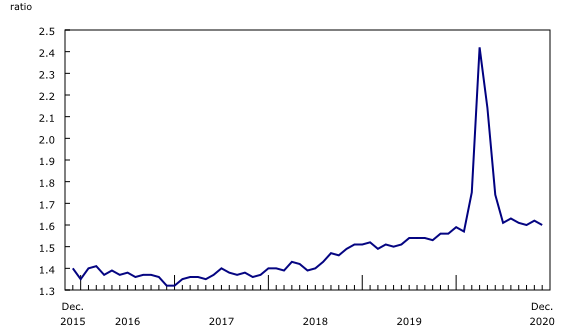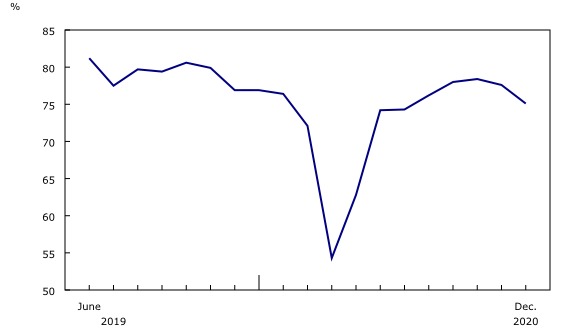Monthly Survey of Manufacturing, December 2020
Archived Content
Information identified as archived is provided for reference, research or recordkeeping purposes. It is not subject to the Government of Canada Web Standards and has not been altered or updated since it was archived. Please "contact us" to request a format other than those available.
Released: 2021-02-15
Manufacturing sales rose 0.9% to $54.2 billion in December. Sales were up in 9 of 21 industries, led by the wood product, transportation equipment, and petroleum and coal product industries.
Manufacturing sales in constant dollars were down 0.4%, indicating that a lower volume of goods was sold in December.
On a quarterly basis, sales rose 1.1% in the fourth quarter, while manufacturing sales in volume terms edged down 0.2%.
Wood product manufacturing leads the gain
Wood product sales increased 8.3% to a record high of $3.7 billion in December, driven by higher prices. Excluding November, sales in the wood product industry have been trending upward since May—they increased 14.6% in the fourth quarter and were up by almost half (+48.1%) year over year. Exports of forestry products and building and packaging materials rose 5.0% in December and were up 16.9% year over year.
Following two consecutive monthly declines, sales in the transportation equipment industry rose 2.3% to $9.2 billion on higher sales of motor vehicles (+1.7%), motor vehicle parts (+2.5%) and railroad rolling stock (+26.9%). Despite the gain in December, sales in the transportation equipment industry were down 9.3% in the fourth quarter and fell 15.6% year over year.
Petroleum and coal product sales rose for the third consecutive month, up 4.7% to $4.2 billion in December on strong energy and petroleum product prices (+9.0%). On a quarterly basis, sales in this industry rose 6.4% in the fourth quarter, while exports of refined petroleum products increased 28.8% in December alone.
Other main contributors to the sales increase in December were the food (+1.2%), paper (+2.7%) and fabricated metal product (+1.4%) industries.
Following four consecutive monthly gains, sales of chemicals fell 4.5% to $4.2 billion in December on lower sales of pharmaceutical and medicine products. Despite the monthly decline, sales in the chemical industry were up 3.1% in the fourth quarter.
Sales also fell in the plastics and rubber products (-3.8%), computer and electronic product (-5.4%), and miscellaneous (-3.2%) industries.
Sales increase in every province except Ontario
Manufacturing sales rose in nine provinces in December, led by British Columbia and Alberta, while sales decreased in Ontario.
Following a 4.5% decline in November, sales in British Columbia rose 4.7% to $4.7 billion in December, primarily on higher sales of wood products (+18.5%) because of higher prices and demand from the residential construction sector in Canada and the United States. Sales of wood products rose 15.2% in the fourth quarter, following a 39.6% increase in the third quarter.
Sales in Alberta were up 2.3% to $5.7 billion in December, the fourth consecutive monthly increase on higher sales of petroleum (+8.4%), wood products (+11.7%) and food (+3.0%). Nonetheless, sales in Alberta were down 5.1% year over year.
Ontario manufacturing sales decreased 0.7% to $24.8 billion in December, following a 0.9% decline in November. Sales were down in 15 of 21 industries in Ontario, led by the chemical (-5.0%) and plastics and rubber products (-5.4%) industries. Higher sales of transportation equipment (+2.5%) offset some of the decline.
Québec census metropolitan area reports the largest increase among selected census metropolitan areas
Manufacturing sales on an unadjusted basis were up in 4 of 12 selected census metropolitan areas in December, led by Québec (+9.5%) and Hamilton (+2.4%).
In Québec, petroleum and coal products, as well as beverage and tobacco products, were responsible for the increase. In Hamilton, the gain was driven by machinery manufacturing.
Sales in Toronto were down 8.8%, the third consecutive monthly decline, on lower sales of motor vehicles (-23.1%) and food (-5.9%). Toronto was harder hit by the pandemic than other census metropolitan areas, and total sales in 2020 were down 9.9% compared with a year earlier.
Inventory levels decline
Following a 0.8% increase in November, total inventories decreased 0.6% to $86.5 billion in December. Lower inventories of transportation equipment (-3.1%) and machinery (-5.7%) were partly offset by higher inventories of petroleum and coal products (+6.8%).
The inventory-to-sales ratio fell from 1.62 in November to 1.60 in December. This ratio measures the time, in months, that would be required to exhaust inventories if sales were to remain at their current level.
Unfilled orders edge up
Unfilled orders edged up 0.3% to $85.4 billion in December, following two consecutive declines. Unfilled orders rose in 12 of 21 industries, led by the fabricated metal product (+4.8%) and computer and electronic product (+5.7%) industries. These increases were partly offset by a 5.1% decline in machinery unfilled orders.
Capacity utilization rate decreases
The capacity utilization rate (not seasonally adjusted) for the total manufacturing sector decreased from 77.6% in November to 75.1% in December because of lower production.
Capacity utilization rates fell in the non-metallic mineral product (-12.9 percentage points), plastics and rubber products (-6.1 percentage points), chemical (-3.7 percentage points), and transportation equipment (-1.5 percentage points) industries. The capacity utilization rate rose 1.0 percentage point in the paper industry.
Manufacturing: Year in review, 2020
Summary
The COVID-19 pandemic changed the world, and those changes were reflected by manufacturing sales falling to their lowest levels since 2015. Transportation equipment and petroleum and coal product sales were all down by more than one-quarter from a year earlier. Wood product manufacturing posted the largest annual growth in sales, on higher new home sales and renovations.
Total manufacturing sales decreased 11.4% to $610.6 billion in 2020, largely because of lower sales in the transportation equipment (-23.5%) and petroleum and coal product (-37.4%) industries. In fact, these two industries alone accounted for three-quarters of the total decline in manufacturing sales in Canada in 2020.
Overall, sales were down in 17 of 21 manufacturing industries.
In constant dollars, sales decreased 9.5% in 2020. The COVID-19 pandemic pushed the volume of manufacturing sales down to its lowest level since 2011. Scaled-back production and widespread shutdowns at the beginning of the pandemic pushed the capacity utilization rate down from 79.6% in 2019 to 73.0% in 2020 on an unadjusted basis.
Following three consecutive annual gains, total inventory levels declined 1.9% to $86.5 billion at the end of 2020, mainly on lower inventories in the petroleum and coal product industry.
Unfilled orders fell 11.3% in 2020, on the heels of a 4.5% decline in 2019. Unfilled orders began 2020 with three consecutive monthly increases, but, following the onset of the pandemic, unfilled orders trended downwards (with the exception of September) to settle at $85.4 billion by year end. The decline was almost entirely attributable to lower unfilled orders of aerospace products in the wake of global travel restrictions.
Manufacturing sales declined in every province in 2020. The transportation equipment industry was the main contributor to the decline in Ontario (-12.1%). In Quebec (-10.0%), the decrease was mostly on lower sales in the petroleum and coal product industry and the transportation equipment industry. Alberta (-15.1%) reported the third-largest dollar drop, mainly on lower sales in the petroleum and coal product industry.
Pandemic hits durable goods industries the hardest, especially motor vehicle and aerospace manufacturers
Sales in durable goods industries declined 12.6% to $317.7 billion in 2020, falling to their lowest level since 2014. The decline was attributable to lower sales of transportation equipment, which fell by almost one-quarter (-23.5%), following a 4.7% gain in 2019.
Most sales lost in transportation equipment manufacturing in 2020 occurred in March and April, when the industry was shut down during the early stages of the pandemic. Sales ramped up from May to July but fell again in August. At year end, transportation equipment manufacturing sales were 13.5% below their pre-pandemic level in February.
Motor vehicle (-28.1%) and motor vehicle parts (-17.5%) sales were both down sharply from a year earlier. Production in the aerospace product and parts industry (-24.0%) fell to its lowest level since 2016, mainly because of travel restrictions and order cancellations.
Other major contributors to the sales decline were the primary metal (-11.7%), machinery (-11.7%) and fabricated metal product (-8.8%) industries.
Conversely, wood product manufacturing rose 15.0%, driven by higher prices. According to the Industrial Product Price Index, the average monthly price for lumber and wood products increased 19.3% in 2020. This growth was attributable to wood shortages, supply chain constraints and higher demand, as Canadians undertook more home renovation projects during the pandemic. The uptick in wood product manufacturing coincided with increased residential building activity and higher retail sales of building materials.
Sales in the miscellaneous industry rose for the third consecutive year, up 5.2% to a record $13.3 billion on higher sales of medical equipment and supplies (+7.3%), including personal protective equipment and other pandemic-related equipment. Increased demand for gold and silver also contributed to higher sales in the miscellaneous industry.
The decline in sales in non-durable goods industries is mostly attributable to lower sales of petroleum and coal products, chemicals, and plastics and rubber products
Sales in non-durable goods industries fell 10.1% to $292.9 billion in 2020, mainly attributable to lower sales of petroleum and coal products.
Sales in the petroleum and coal product industry fell by over one-third (-37.4%) to $46.1 billion on low global demand during the pandemic. The decline was mostly attributable to lower petroleum refinery production and prices. The monthly average prices for energy and petroleum products fell by over one-quarter (-27.5%) in 2020.
The petroleum and coal product industry also posted the largest drop in total inventories, falling by slightly less than one-quarter (-23.7%) on a seasonally adjusted basis by year end. The capacity utilization rate declined 11.6 percentage points, as refineries cut production in the wake of lower consumer demand.
Chemical manufacturing sales declined 6.1% to $50.5 billion, following a 4.4% decrease in 2019. Basic chemical manufacturing (-13.6%), which includes petrochemicals, posted the largest decline, on lower petroleum production.
Following a decade of growth, sales of plastics and rubber products fell 8.4% to $30.3 billion in 2020. The decline partially reflected the weakness in the transportation equipment industry, given that, on average, one-quarter of plastic and rubber sales are attributable to auto parts.
Paper manufacturing sales declined for the second consecutive year, falling 4.3% to $27.0 billion on lower sales of pulp, paper and paperboard mills. The decline was due to lower demand for printing and writing paper as non-essential businesses, government offices and schools were shut down for extended periods in 2020.
The decline in the paper industry was largely attributable to prices, as the volume of paper products sold increased 2.2%. Average prices of paper manufacturing products decreased 3.6%, mostly on lower prices for pulp and new paper.
Conversely, sales in converted paper product manufacturing rose 12.8% in 2020 on increased demand for paper bags and corrugated and solid fibre boxes during the pandemic.
Food manufacturing sales rose 3.4% to $110.0 billion in 2020, their 13th consecutive annual increase, on higher sales of dairy products (+16.8%) and meat (+2.9%). Meat manufacturing sales rose despite the COVID-19 outbreaks that forced two large meat plants in Alberta to close at the beginning of the pandemic. The grain and oilseed milling industry posted the largest decline (-3.6%) in 2020, partly because of lower exports.
Beverage and tobacco product sales increased 5.8% to $15.4 billion, the 10th consecutive annual gain. The growth reflected mostly higher sales of beverage products, which reached a record high in 2020.
Sustainable development goals
On January 1, 2016, the world officially began implementing the 2030 Agenda for Sustainable Development, the United Nations' transformative plan of action that addresses urgent global challenges over the following 15 years. The plan is based on 17 specific sustainable development goals.
The Monthly Survey of Manufacturing is an example of how Statistics Canada supports the reporting on the global sustainable development goals. This release will be used to help measure the following goal:

Note to readers
While the quality of this month's data remains high, response rates from manufacturers have fallen from the usual 95% to a rate of 88.1% in December. Every effort has been made to supplement this month's data with information from other sources.
Monthly data in this release are seasonally adjusted and are expressed in current dollars unless otherwise specified.
Seasonally adjusted data are data that have been modified to eliminate the effect of seasonal and calendar influences to allow for more meaningful comparisons of economic conditions from period to period. For more information on seasonal adjustment, see Seasonally adjusted data – Frequently asked questions.
Trend-cycle estimates are included in selected charts as a complement to the seasonally adjusted series. These data represent a smoothed version of the seasonally adjusted time series and provide information on longer-term movements, including changes in direction underlying the series. For information on trend-cycle data, see Trend-cycle estimates – Frequently asked questions.
Both seasonally adjusted data and trend-cycle estimates are subject to revision as additional observations become available. These revisions could be large and could even lead to a reversal of movement, especially for reference months near the end of the series or during periods of economic disruption.
Non-durable goods industries include food, beverage and tobacco products, textile mills, textile product mills, clothing, leather and allied products, paper, printing and related support activities, petroleum and coal products, chemicals, and plastics and rubber products.
Durable goods industries include wood products; non-metallic mineral products; primary metals; fabricated metal products; machinery; computer and electronic products; electrical equipment, appliances and components; transportation equipment; furniture and related products; and miscellaneous manufacturing.
Production-based industries
For the aerospace and shipbuilding industries, the value of production is used instead of the value of sales of goods manufactured. The value of production is calculated by adjusting monthly sales of goods manufactured by the monthly change in inventories of goods in process and finished products manufactured. The value of production is used because of the extended period of time that it normally takes to manufacture products in these industries.
Unfilled orders are a stock of orders that will contribute to future sales assuming that the orders are not cancelled.
New orders are those received, whether sold in the current month or not. They are measured as the sum of sales for the current month plus the change in unfilled orders from the previous month to the current month.
Manufacturers reporting sales, inventories and unfilled orders in US dollars
Some Canadian manufacturers report sales, inventories and unfilled orders in US dollars. These data are then converted to Canadian dollars as part of the data production cycle.
For sales, based on the assumption that they occur throughout the month, the average monthly exchange rate for the reference month established by the Bank of Canada is used for the conversion. The monthly average exchange rate is available in table 33-10-0163-01. Inventories and unfilled orders are reported at the end of the reference period. For most respondents, the daily average exchange rate on the last working day of the month is used for the conversion of these variables.
However, some manufacturers choose to report their data as of a day other than the last day of the month. In these instances, the daily average exchange rate on the day selected by the respondent is used. Note that because of exchange rate fluctuations, the daily average exchange rate on the day selected by the respondent can differ from both the exchange rate on the last working day of the month and the monthly average exchange rate. Daily average exchange rate data are available in table 33-10-0036-01.
Revision policy
Each month, the Monthly Survey of Manufacturing releases preliminary data for the reference month and revised data for the three previous months. Revisions are made to reflect new information provided by respondents and updates to administrative data.
Once a year, a revision project is undertaken to revise multiple years of data.
Real-time data tables
Real-time data tables 16-10-0118-01, 16-10-0119-01, 16-10-0014-01 and 16-10-0015-01 will be updated on February 22.
Next release
Data from the Monthly Survey of Manufacturing for January will be released on March 15.
Contact information
For more information, or to enquire about the concepts, methods or data quality of this release, contact us (toll-free 1-800-263-1136; 514-283-8300; STATCAN.infostats-infostats.STATCAN@canada.ca) or Media Relations (613-951-4636; STATCAN.mediahotline-ligneinfomedias.STATCAN@canada.ca).
- Date modified:








